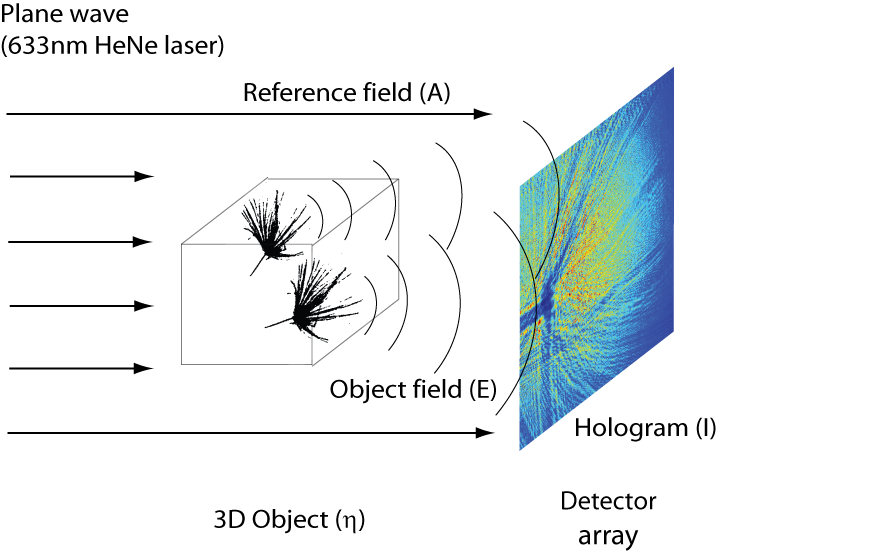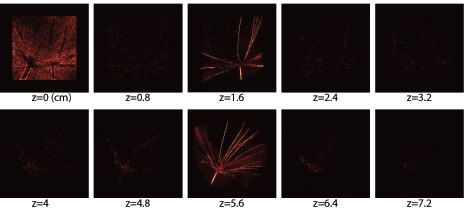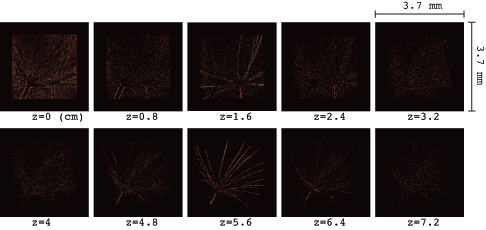The content linked on this page refer to the journal paper published by David J. Brady et al., "Compressive Holography", Opt. Express 17, 13040-13049 (2009).
Gabor holography is an amazingly simple and effective encoder for compressive sampling. Decompressive inference improves holographic systems by increasing the number of pixels or voxels one can infer from a single hologram and by resolving reconstruction ambiguities. Holography is a comparatively effective encoder for compressive imaging because holographic multiplex measurement weights are complex valued.

We illuminated two seed parachutes of common dandelions (taraxacum) with a collimated, spatially filtered Helium-Neon laser of 632.8 nm wavelength. One object is placed 1.5 cm away from the detector array, and the other dandelion is placed 5.5 cm away from the detector array.

The illumination and scattered fields were captured in the Gabor hologram shown in Figure (a). Figures (b) and (c) are photographs of the two seed parachutes. Figure (d) is the 3D datacube estimated from the Gabor recording by the TV-minimization algorithm. As the reconstruction shows, the stem and the petals, representing the high-frequency features in the image, are reconstructed well. In addition, the distance between the detector plane and the first parachute and the distance between the two parachutes are also accurately estimated. The reconstruction error in the plane of z = 0 is explained in the online supporting material. Figure (d) is a 512*512*9 datacube of voxels with 5.2 micron transverse resolution and 0.8 cm axial resolution reconstructed from a single 512*512 hologram. This demonstrates the main advantages of compressive holography, i.e. that holograms naturally encode high quality multiplex data and that decompressive inference can infer multidimensional objects from lower dimensional data. Extensions of compressive holography may use off-axis encoding to filter nonlinear terms and multispectral illumination to increase the band volume and improve axial resolution.


Figure is the 3D datacube estimated from the Gabor recording by l1 minimization algorithm. The optimization problem is defined in the main paper, and we again adapt the two-step iterative shrinkage/thresholding algorithm (TwIST) to solve the l1 minimization problem. While the two object planes show reasonably good reconstructions, the errors in the other planes are larger in the l1-minimization estimate.

Figure (a) shows the reconstruction from a simulated squared field e, a rectangle with no diffraction patterns. As expected, all the signal e remains in the plane of z = 0 since there is no information pertaining to which plane it diffracts from, meaning that the correlation of e with any object plane is small. In figure (b) , we simulated a 3D object that has a rectangle in some object planes from which the simulated squared field e is generated; the reconstruction is produced from only e without the field E. As the reconstruction illustrates, the reconstruction contains a small error in some object planes induced by little correlation between e and the interference patterns that the estimated object would produce.


[The operation code below the result figure is downloadable by clicking the blue-labeled caption.]
Computer Specification
The reconstruction was performed on a digital computer with Intel Core2 Quad CPU Q9300 at 2.5 GHz and 8 GB of RAM. The codes were written in Matlab 7.7